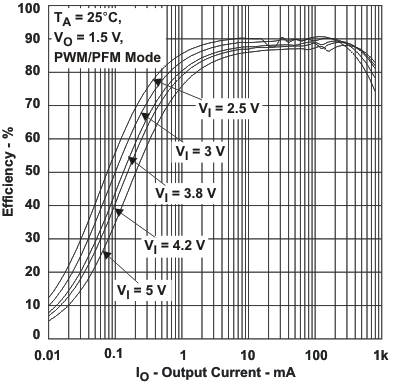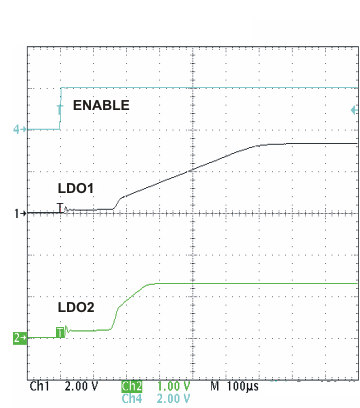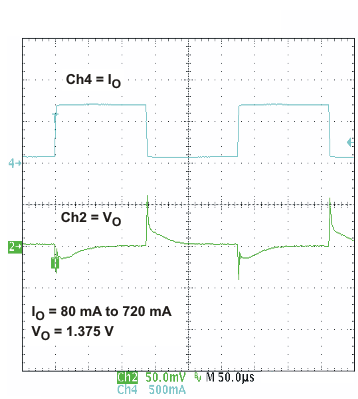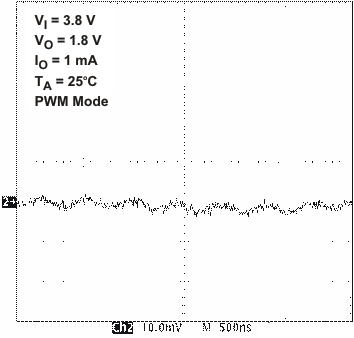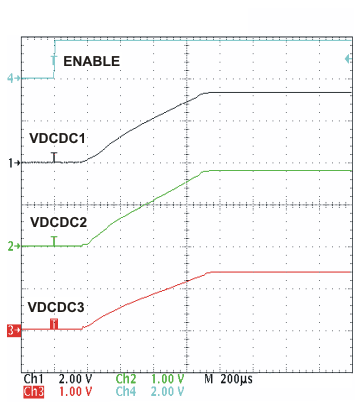SLVS774C June 2007 – January 2016 TPS650240 , TPS650241 , TPS650242 , TPS650243 , TPS650244 , TPS650245
PRODUCTION DATA.
- 1 Features
- 2 Applications
- 3 Description
- 4 Revision History
- 5 Description (continued)
- 6 Pin Configuration and Functions
-
7 Specifications
- 7.1 Absolute Maximum Ratings
- 7.2 ESD Ratings
- 7.3 Recommended Operating Conditions
- 7.4 Thermal Information
- 7.5 Electrical Characteristics: Control Signals and Supply Pins
- 7.6 Electrical Characteristics: VDCDC1 Step-Down Converter
- 7.7 Electrical Characteristics: VDCDC2 Step-Down Converter
- 7.8 Electrical Characteristics: VDCDC3 Step-Down Converter
- 7.9 Electrical Characteristics: General
- 7.10 Typical Characteristics
- 8 Detailed Description
- 9 Application and Implementation
- 10Power Supply Recommendations
- 11Layout
- 12Device and Documentation Support
- 13Mechanical, Packaging, and Orderable Information
Package Options
Mechanical Data (Package|Pins)
- RHB|32
Thermal pad, mechanical data (Package|Pins)
- RHB|32
Orderable Information
7 Specifications
7.1 Absolute Maximum Ratings
over operating free-air temperature range (unless otherwise noted) (1)| MIN | MAX | UNIT | ||
|---|---|---|---|---|
| Input voltage range on all pins except A/PGND, VLDO1, and VLDO2 pins, with respect to AGND |
–0.3 | 7 | V | |
| Voltage range on pins VLDO1 and VLDO2 with respect to AGND | –0.3 | 3.6 | V | |
| Current at VINDCDC1, L1, PGND1, VINDCDC2, L2, PGND2, VINDCDC3, L3, PGND3 | 2000 | mA | ||
| Peak current at all other pins | 1000 | mA | ||
| TA | Operating free-air temperature | –40 | 85 | °C |
| TJ | Maximum junction temperature | 125 | °C | |
| Lead temperature 1.6 mm (1/16-inch) from case for 10 seconds | 260 | °C | ||
| Tstg | Storage temperature | –65 | 150 | °C |
(1) Stresses beyond those listed under Absolute Maximum Ratings may cause permanent damage to the device. These are stress ratings only, which do not imply functional operation of the device at these or any other conditions beyond those indicated under Recommended Operating Conditions. Exposure to absolute-maximum-rated conditions for extended periods may affect device reliability.
7.2 ESD Ratings
| VALUE | UNIT | |||
|---|---|---|---|---|
| V(ESD) | Electrostatic discharge | Human-body model (HBM), per ANSI/ESDA/JEDEC JS-001(1) | ±2500 | V |
| Charged-device model (CDM), per JEDEC specification JESD22-C101(2) | ±1500 | |||
(1) JEDEC document JEP155 states that 500-V HBM allows safe manufacturing with a standard ESD control process.
(2) JEDEC document JEP157 states that 250-V CDM allows safe manufacturing with a standard ESD control process.
7.3 Recommended Operating Conditions
| MIN | NOM | MAX | UNIT | ||
|---|---|---|---|---|---|
| VINDCDC1, VINDCDC2, VINDCDC3, VCC | Input voltage range step-down converters | 2.5 | 6 | V | |
| VDCDC1 | Output voltage range for VDCDC1 step-down converter(1) | 0.6 | VINDCDC1 | V | |
| VDCDC2 | Output voltage range for mem step-down converter(1) | 0.6 | VINDCDC2 | V | |
| VDCDC3 | Output voltage range for core step-down converter | 0.9 | 1.5 | V | |
| VINLDO1, VINLDO2 | Input voltage range for LDOs | 1.5 | 6.5 | V | |
| VLDO1-2 | Output voltage range for LDOs | 1 | 3.3 | V | |
| IOUTDCDC1 | Output current at L1 | 1600 | mA | ||
| L1 | Inductor at L1(2) | 1.5 | 2.2 | μH | |
| CINDCDC1 | Input capacitor at VINDCDC1 (2) | 10 | μF | ||
| COUTDCDC1 | Output capacitor at VDCDC1 (2) | 10 | 22 | μF | |
| IOUTDCDC2 | Output current at L2 | 1600 | mA | ||
| L2 | Inductor at L2(2) | 1.5 | 2.2 | μH | |
| CINDCDC2 | Input capacitor at VINDCDC2 (2) | 10 | μF | ||
| COUTDCDC2 | Output capacitor at VDCDC2 (2) | 10 | 22 | μF | |
| IOUTDCDC3 | Output current at L3 | 800 | mA | ||
| L3 | Inductor at L3(2) | 1.5 | 2.2 | μH | |
| CINDCDC3 | Input capacitor at VINDCDC3 (2) | 10 | μF | ||
| COUTDCDC3 | Output capacitor at VDCDC3 (2) | 10 | 22 | μF | |
| CVcc | Input capacitor at VCC(2) | 1 | μF | ||
| Cin1-2 | Input capacitor at VINLDO(2) | 1 | μF | ||
| COUT1-2 | Output capacitor at VLDO1, VLDO2(2) | 2.2 | μF | ||
| ILDO1,2 | Output current at VLDO1, VLDO2 | 200 | mA | ||
| CVRTC | Output capacitor at Vdd_alive(2) | 2.2 | μF | ||
| IVdd_alive | Output current at Vdd_alive | 30 | mA | ||
| TA | Operating ambient temperature | –40 | 85 | °C | |
| TJ | Operating junction temperature | –40 | 125 | °C | |
| RCC | Resistor from VINDCDC3,VINDCDC2, VINDCDC1 to VCC used for filtering(3) | 1 | 10 | Ω | |
(1) When using an external resistor divider at DEFDCDC2, DEFDCDC1.
(2) See Inductor Selection for the DC-DC Converters for more information, for Vout > 2.85 V choose 3.3-μH inductor.
(3) Up to 2.5-mA can flow into VCC when all 3 converters are running in PWM, this resistor causes the UVLO threshold to be shifted accordingly.
7.4 Thermal Information
| THERMAL METRIC(1) | TPS650240 | UNIT | |
|---|---|---|---|
| RHB (VQFN) | |||
| 32 PINS | |||
| RθJA | Junction-to-ambient thermal resistance | 32.2 | °C/W |
| RθJC(top) | Junction-to-case (top) thermal resistance | 22.0 | °C/W |
| RθJB | Junction-to-board thermal resistance | 6.2 | °C/W |
| ψJT | Junction-to-top characterization parameter | 0.3 | °C/W |
| ψJB | Junction-to-board characterization parameter | 6.1 | °C/W |
| RθJC(bot) | Junction-to-case (bottom) thermal resistance | 1.7 | °C/W |
(1) For more information about traditional and new thermal metrics, see the Semiconductor and IC Package Thermal Metrics application report (SPRA953).
7.5 Electrical Characteristics: Control Signals and Supply Pins
VINDCDC1 = VINDCDC2 = VINDCDC3 = VCC = VINLDO = 3.6 V, TA = –40°C to +85°C, typical values are at TA = 25°C (unless otherwise noted)| PARAMETER | TEST CONDITIONS | MIN | TYP(1) | MAX | UNIT | |||
|---|---|---|---|---|---|---|---|---|
| CONTROL SIGNALS: EN_DCDC1, EN_DCDC2, EN_DCDC3, EN_LDO, MODE, EN_VDD_ALIVE | ||||||||
| VIH | High level input voltage | 1.45 | VCC | V | ||||
| VIL | Low level input voltage | 0 | 0.4 | V | ||||
| IH | Input bias current | 0.01 | 0.1 | μA | ||||
| SUPPLY PINS: VCC, VINDCDC1, VINDCDC2, VINDCDC3 | ||||||||
| I(qPFM) | Operating quiescent current | VCC = 3.6 V | PFM all 3 DCDC converters enabled, zero load and no switching, LDOs enabled |
135 | 170 | uA | ||
| PFM all 3 DCDC converters enabled, zero load and no switching, LDO1, LDO2 = OFF, Vdd_alive = ON |
75 | 100 | ||||||
| PFM DCDC1 and DCDC2 converters enabled, zero load and no switching, LDO1, LDO2 = OFF, Vdd_alive = ON |
55 | 80 | ||||||
| PFM DCDC1 converter enabled, zero load and no switching, LDO1, LDO2 = OFF, Vdd_alive = ON |
40 | 60 | ||||||
| IVcc(PWM) | Current into VCC; PWM | VCC = 3.6 V | All 3 DCDC converters enabled and running in PWM, LDOs off |
2 | mA | |||
| PWM DCDC1 and DCDC2 converters enabled and running in PWM, LDOs off |
1.5 | 2.5 | ||||||
| PWM DCDC1 converter enabled and running in PWM, LDOs off |
0.85 | 2 | ||||||
| Iq | Quiescent current | VCC = 3.6 V | All converters disabled, LDO1, LDO2 = OFF, Vdd_alive = OFF |
16 | μA | |||
| All converters disabled, LDO1, LDO2 = OFF, Vdd_alive = ON |
26 | |||||||
(1) Typical values are at TA = 25°C
7.6 Electrical Characteristics: VDCDC1 Step-Down Converter
VINDCDC1 = VINDCDC2 = VINDCDC3 = VCC = VINLDO = 3.6 V, TA = –40°C to +85°C, typical values are at TA = 25°C (unless otherwise noted)| PARAMETER | TEST CONDITIONS | MIN | TYP(1) | MAX | UNIT | |||
|---|---|---|---|---|---|---|---|---|
| VVINDCDC1 | Input voltage range | 2.5 | 6 | V | ||||
| IO | Maximum output current for TPS650240, TPS650242, and TPS650245 | VO = 3.3 V | 1000 | mA | ||||
| IO | Maximum output current for TPS650241 and TPS650243 | VO = 3.3 V | 1600 | mA | ||||
| IO | Maximum output current for TPS650244 | VO = 3.3 V | 800 | mA | ||||
| ISD | Shutdown supply current in VINDCDC1 | EN_DCDC1 = GND | 0.1 | 1 | μA | |||
| RDS(ON) | P-channel MOSFET ON-resistance | VINDCDC1 = VGS = 3.6 V | 125 | 261 | mΩ | |||
| ILP | P-channel leakage current | VINDCDC1 = 6 V | 2 | μA | ||||
| RDS(ON) | N-channel MOSFET ON-resistance | VINDCDC1 = VGS = 3.6 V | 130 | 260 | mΩ | |||
| ILN | N-channel leakage current | VDS = 6.0 V | 7 | 10 | μA | |||
| ILIMF | Forward current limit (P- and N-channel) for TPS650244 | 2.5 V < VINMAIN < 6.0 V | 0.98 | 1.1 | 1.21 | A | ||
| Forward current limit (P- and N-channel) for TPS650240, TPS650242, and TPS650245 | 2.5 V < VINMAIN < 6.0 V | 1.15 | 1.3 | 1.39 | A | |||
| Forward current limit (P- and N-channel) for TPS650241 and TPS650243 | 2.5 V < VINMAIN < 6.0 V | 1.75 | 1.97 | 2.15 | A | |||
| fS | Oscillator frequency | 1.95 | 2.25 | 2.55 | MHz | |||
| VDCDC1 | Fixed output voltage MODE = 0 (PWM/PFM) | VINDCDC1 = 3.3 V to 6 V; 0 mA ≤ IO ≤ 1.6 A |
2.80 V | –2% | 2% | |||
| 3.3 V | –2% | 2% | ||||||
| Fixed output voltage MODE = 1 (PWM) | VINDCDC1 = 3.7 V to 6 V; 0 mA ≤ IO ≤ 1.6 A |
2.80 V | –1% | 1% | ||||
| 3.3 V | –1% | 1% | ||||||
| Adjustable output voltage with resistor divider at DEFDCDC1; MODE = 0 (PWM/PFM) | VINDCDC1 = VDCDC1 +0.4 V (min 2.5 V) to 6 V; 0 mA ≤ IO ≤ 1.6 A | –2% | 2% | |||||
| Adjustable output voltage with resistor divider at DEFDCDC1; MODE = 1 (PWM) | VINDCDC1 = VDCDC1 +0.4 V (min 2.5 V) to 6 V; 0 mA ≤ IO ≤ 1.6 A | –1% | 1% | |||||
| Line regulation | VINDCDC1 = VDCDC1 + 0.3 V (min 2.5 V) to 6 V; IO = 10 mA | 0% | V | |||||
| Load regulation | IO = 10 mA to 1.6 A | 0.25% | A | |||||
| TSS | Soft-start ramp time | VDCDC1 ramping from 5% to 95% of target value | 750 | μs | ||||
| R(L1) | Internal resistance from L1 to GND | 1 | MΩ | |||||
(1) Typical values are at TA = 25°C
7.7 Electrical Characteristics: VDCDC2 Step-Down Converter
VINDCDC1 = VINDCDC2 = VINDCDC3 = VCC = VINLDO = 3.6V, TA = –40°C to +85°C, typical values are at TA = 25°C (unless otherwise noted)| PARAMETER | TEST CONDITIONS | MIN | TYP(1) | MAX | UNIT | |||
|---|---|---|---|---|---|---|---|---|
| VVINDCDC2 | Input voltage range | 2.5 | 6 | V | ||||
| IO | Maximum output current for TPS650240, TPS650242, and TPS650245 | VO = 2.5 V | 800 | mA | ||||
| IO | Maximum output current for TPS650241 and TPS650243 | VO = 2.5 V | 1000 | mA | ||||
| IO | Maximum output current for TPS650244 | VO = 2.5 V | 1600 | mA | ||||
| ISD | Shutdown supply current in VINDCDC2 | EN_DCDC2 = GND | 0.1 | 1 | μA | |||
| RDS(ON) | P-channel MOSFET ON-resistance | VINDCDC2 = VGS = 3.6 V | 140 | 300 | mΩ | |||
| ILP | P-channel leakage current | VINDCDC2 = 6 V | 2 | μA | ||||
| RDS(ON) | N-channel MOSFET ON-resistance | VINDCDC2 = VGS = 3.6 V | 150 | 297 | mΩ | |||
| ILN | N-channel leakage current | VDS = 6 V | 7 | 10 | μA | |||
| ILIMF | Forward current limit (P- and N-channel) for TPS650240, TPS650242, and TPS650245 | 2.5 V < VINDCDC2 < 6 V | 1.05 | 1.16 | 1.29 | A | ||
| ILIMF | Forward current limit (P- and N-channel) for TPS650241 and TPS650243 | 2.5 V < VINDCDC2 < 6 V | 1.22 | 1.35 | 1.5 | A | ||
| ILIMF | Forward current limit (P- and N-channel) for TPS650244 | 2.5 V < VINDCDC2 < 6 V | 1.75 | 1.97 | 2.15 | A | ||
| fS | Oscillator frequency | 1.95 | 2.25 | 2.55 | MHz | |||
| VDCDC2 | Fixed output voltage MODE = 0 (PWM/PFM) | VINDCDC2 = 2.5 V to 6 V; 0 mA ≤ IO ≤ 1.6 A |
1.8 V | –2% | 2% | |||
| VINDCDC2 = 3.0 V to 6 V; 0 mA ≤ IO ≤ 1.6 A |
2.5 V | –2% | 2% | |||||
| Fixed output voltage MODE = 1 (PWM) | VINDCDC2 = 2.5 V to 6 V; 0 mA ≤ IO ≤ 1.6 A |
1.8 V | –2% | 2% | ||||
| VINDCDC2 = 3.0 V to 6 V; 0 mA ≤ IO ≤ 1.6 A |
2.5 V | –1% | 1% | |||||
| Adjustable output voltage with resistor divider at DEFDCDC2; MODE = 0 (PWM) | VINDCDC2 = VDCDC2 + 0.5 V (min 2.5 V) to 6 V; 0 mA ≤ IO ≤ 1.6 A | –2% | 2% | |||||
| Adjustable output voltage with resistor divider at DEFDCDC2; MODE = 1 (PWM) | VINDCDC2 = VDCDC2 + 0.5 V (min 2.5 V) to 6 V; 0 mA ≤ IO ≤ 1.6 A | –1% | 1% | |||||
| Line regulation | VINDCDC2 = VDCDC2 + 0.3 V (min 2.5 V) to 6 V; IO = 10 mA | 0% | V | |||||
| Load regulation | IO = 10 mA to 1.6 A | 0.25% | A | |||||
| TSS | Soft-start ramp time | VDCDC2 ramping from 5% to 95% of target value | 750 | μs | ||||
| R(L2) | Internal resistance from L2 to GND | 1 | MΩ | |||||
(1) Typical values are at TA = 25°C
7.8 Electrical Characteristics: VDCDC3 Step-Down Converter
VINDCDC1 = VINDCDC2 = VINDCDC3 = VCC = VINLDO = 3.6V, TA = –40°C to +85°C, typical values are at TA = 25°C (unless otherwise noted)| PARAMETER | TEST CONDITIONS | MIN | TYP(1) | MAX | UNIT | |||
|---|---|---|---|---|---|---|---|---|
| VVINDCDC3 | Input voltage range | 2.5 | 6 | V | ||||
| IO | Maximum output current | VO = 1.6 V | 800 | mA | ||||
| ISD | Shutdown supply current in VINDCDC3 | EN_DCDC3 = GND | 0.1 | 1 | μA | |||
| RDS(ON) | P-channel MOSFET ON-resistance | VINDCDC3 = VGS = 3.6 V | 310 | 698 | mΩ | |||
| ILP | P-channel leakage current | VINDCDC3 = 6.0 V | 0.1 | 2 | μA | |||
| RDS(ON) | N-channel MOSFET ON-resistance | VINDCDC3 = VGS = 3.6 V | 220 | 503 | mΩ | |||
| ILN | N-channel leakage current | VDS = 6 V | 7 | 10 | μA | |||
| ILIMF | Forward current limit (P- and N-channel) | 2.5 V < VINDCDC3 < 6 V | 1 | 1.2 | 1.4 | A | ||
| fS | Oscillator frequency | 1.95 | 2.25 | 2.55 | MHz | |||
| VDCDC3 | Fixed output voltage MODE = 0 (PWM/PFM) | VINDCDC3 = 2.5 V to 6 V; 0 mA ≤ IO ≤ 800 mA, VO = 0.9 V to 1.6 V |
–2% | 2% | ||||
| Fixed output voltage MODE = 1 (PWM) | –1% | 1% | ||||||
| Line regulation | VINDCDC3 = VDCDC3 + 0.3 V (min. 2.5 V) to 6 V; IO = 10 mA |
0% | V | |||||
| Load regulation | IO = 10 mA to 600 mA | 0.25% | A | |||||
| TSS | Soft-start ramp time | VDCDC3 ramping from 5% to 95% of target value | 750 | μs | ||||
| R(L3) | Internal resistance from L3 to GND | 1 | MΩ | |||||
(1) Typical values are at TA = 25°C
7.9 Electrical Characteristics: General
VINDCDC1 = VINDCDC2 = VINDCDC3 = VCC = VINLDO = 3.6V, TA = –40°C to +85°C, typical values are at TA = 25°C (unless otherwise noted)| PARAMETER | TEST CONDITIONS | MIN | TYP(2) | MAX | UNIT | |
|---|---|---|---|---|---|---|
| VLDO1 AND VLDO2 LOW DROPOUT REGULATORS | ||||||
| I(q) | Operating quiescent current | Current per LDO into VINLDO | 16 | 30 | μA | |
| I(SD) | Shutdown current | Total current into VINLDO, VLDO = 0 V | 0.6 | 2 | μA | |
| VINLDO | Input voltage range for LDO1, LDO2 | 1.5 | 6.5 | V | ||
| VLDO1 | LDO1 output voltage range | 1 | 3.3 | V | ||
| VLDO2 | LDO2 output voltage range | 1 | 3.3 | V | ||
| VFB | LDO1 and LDO2 feedback voltage | See (1) | 1 | V | ||
| IO | Maximum output current for LDO1, LDO2 | Vin = 1.8 V, Vo = 1.3 V | 200 | mA | ||
| IO | Maximum output current for LDO1, LDO2 | Vin = 1.5 V; Vo = 1.3 V | 120 | mA | ||
| ISC | LDO1 & LDO2 short circuit current limit | VLDO1 = GND, VLDO2 = GND | 400 | mA | ||
| Minimum voltage drop at LDO1, LDO2 | IO = 50 mA, VINLDO = 1.8 V | 120 | mV | |||
| Minimum voltage drop at LDO1, LDO2 | IO = 50 mA, VINLDO = 1.5 V | 65 | 150 | mV | ||
| Minimum voltage drop at LDO1, LDO2 | IO = 200 mA, VINLDO = 1.8 V | 300 | mV | |||
| Output voltage ccuracy for LDO1, LDO2 | IO = 10 mA | –2% | 1% | |||
| Line regulation for LDO1, LDO2 | VINLDO1,2 = VLDO1,2 + 0.5 V (min. 2.5 V) to 6.5 V, IO = 10 mA | –1% | 1% | |||
| Load regulation for LDO1, LDO2 | IO = 0 mA to 200 mA | –1% | 1% | |||
| Regulation time for LDO1, LDO2 | Load change from 10% to 90% | 10 | μs | |||
| Vdd_alive LOW DROPOUT REGULATOR | ||||||
| Vdd_alive | Vdd_alive LDO output voltage, TPS650240 to TPS650244 |
IO = 0 mA | 1.2 | V | ||
| Vdd_alive LDO output voltage, TPS650245 |
IO = 0 mA | 1.1 | ||||
| IO | Output current for Vdd_alive | 30 | mA | |||
| ISC | Vdd_alive short circuit current limit | Vdd_alive = GND | 100 | mA | ||
| Output voltage accuracy for Vdd_alive | IO = 0 mA | –1% | 1% | |||
| Line regulation for Vdd_alive | VCC = Vdd_alive + 0.5 V to 6.5 V, IO = 0 mA | –1% | 1% | |||
| Regulation time for Vdd_alive | Load change from 10% to 90% | 10 | μs | |||
| ANALOGIC SIGNALS DEFDCDC1, DEFDCDC2, DEFDCDC3 | ||||||
| VIH | High level input voltage | 1.3 | VCC | V | ||
| VIL | Low level input voltage | 0 | 0.1 | V | ||
| IH | Input bias current | 0.001 | 0.05 | μA | ||
| THERMAL SHUTDOWN | ||||||
| TSD | Thermal shutdown | Increasing junction temperature | 160 | °C | ||
| Thermal shudown hysteresis | Decreasing junction temperature | 20 | °C | |||
| INTERNAL UNDER VOLTAGE LOCK OUT | ||||||
| UVLO | Internal UVLO | VCC falling | –3% | 2.35 | 3% | V |
| VUVLO_HYST | Internal UVLO comparator hysteresis | 120 | mV | |||
| VOLTAGE DETECTOR COMPARATOR | ||||||
| PWRFAIL_SNS | Comparator threshold | Falling threshold | –2% | 1 | 2% | V |
| Hysteresis | 40 | 50 | 60 | mV | ||
| Propagation delay | 25 mV overdrive | 10 | μs | |||
| VOL | Power fail output low voltage | IOL = 5 mA | 0.3 | V | ||
(1) If the feedback voltage is forced higher than above 1.2 V, a leakage current into the feedback pin may occur.
(2) Typical values are at TA = 25°C
7.10 Typical Characteristics
Table 1. Table of Graphs
| FIGURE | |||
|---|---|---|---|
| η | Efficiency VDCDC1 | vs Load current PWM/PFM; VO = 3.3 V | Figure 1 |
| η | Efficiency VDCDC1 | vs Load current PWM; VO = 3.3 V | Figure 2 |
| η | Efficiency VDCDC2 | vs Load current PWM/PFM; VO = 1.8 V | Figure 3 |
| η | Efficiency VDCDC2 | vs Load current PWM; VO = 1.8 V | Figure 4 |
| η | Efficiency VDCDC3 | vs Load current PWM/PFM; VO = 1.3 V | Figure 5 |
| η | Efficiency VDCDC3 | vs Load current PWM; VO = 1.3 V | Figure 6 |
| Line transient response VDCDC1 | Figure 7 | ||
| Line transient response VDCDC2 | Figure 8 | ||
| Line transient response VDCDC3 | Figure 9 | ||
| Load transient response VDCDC1 | Figure 10 | ||
| Load transient response VDCDC2 | Figure 11 | ||
| Load transient response VDCDC3 | Figure 12 | ||
| Output voltage ripple DCDC2; PFM mode | Figure 13 | ||
| Output voltage ripple DCDC2; PWM mode | Figure 14 | ||
| Load regulation for Vdd_alive | Figure 15 | ||
| Start-up VDCDC1 to VDCDC3 | Figure 16 | ||
| Start-up LDO1 and LDO2 | Figure 17 | ||


